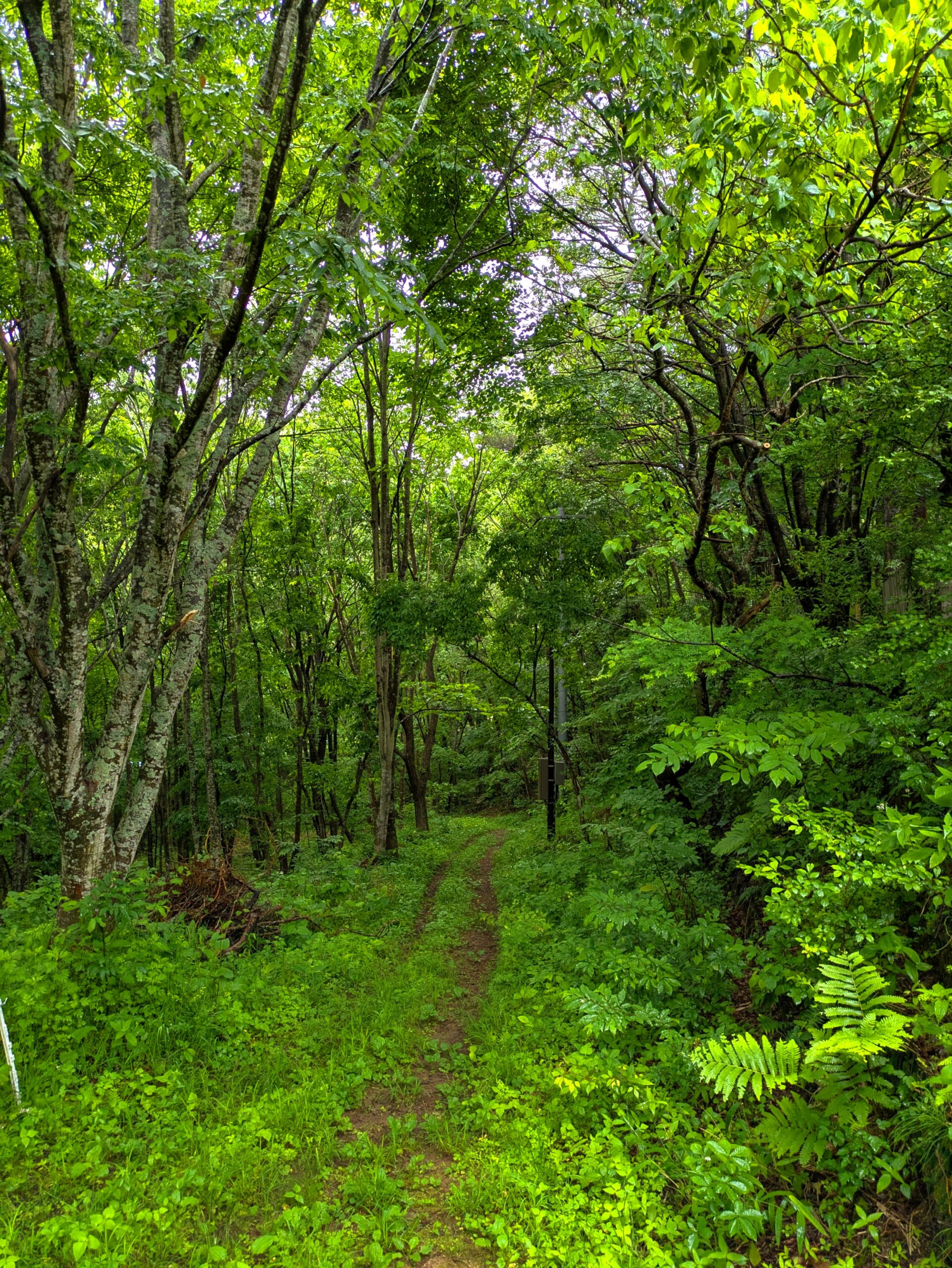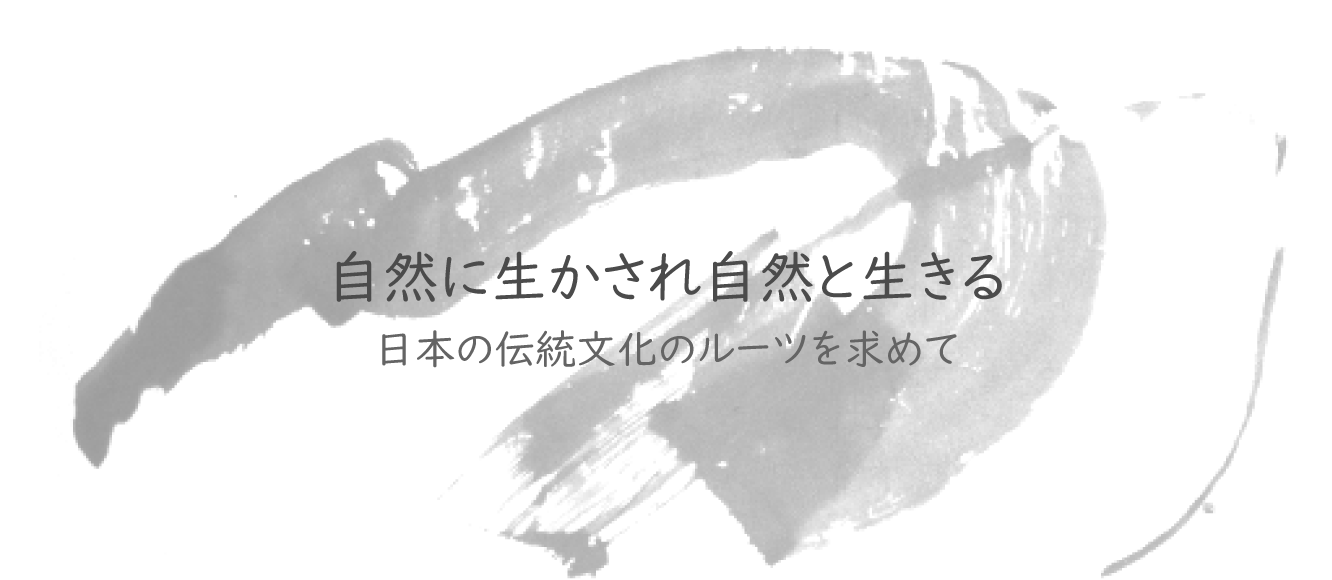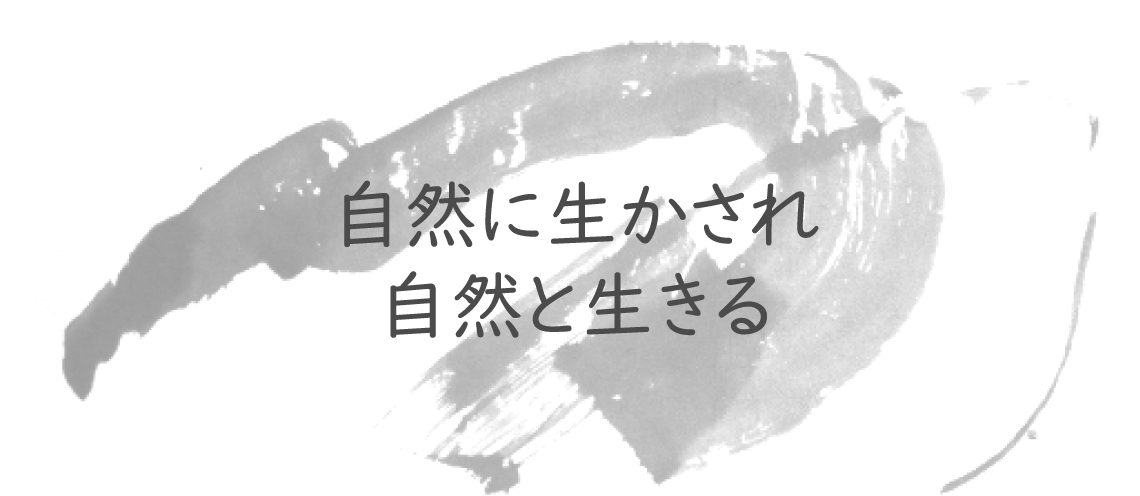縁友往来Message from Soulmates
- 縁友往来
- The Immensity of a Forest—生命共同体の一員になるには
The Immensity of a Forest—生命共同体の一員になるには

Tono—Biodiverse Forests and a Strong Horse Culture
「南部馬」の故郷として知られている遠野。
岩手県、遠野。その広い放牧地や豊富な水資源が馬の育成に適している。南部馬は明治時代に絶滅したが、遠野の人々は今、馬の文化を再生・継承するように力を入れている。その大プロジェクトの一つが「クイーンズメドウ・カントリーハウス馬付住宅プロジェクト」です。
At dawn in mid-June, Ishikawa and I drove to Tono in Iwate Prefecture. Arriving at noon, we met up with Tono architect Keiji Shimizu, who had arranged for our stay at Queen’s Meadow Country House, a mountain guesthouse with a horse stable under the same roof.
初夏の爽やかな日に、石川さんの車で岩手県の遠野へ向かった。遠野を拠点に活動している建築家の清水さんの誘いで、石川は「クイーンズメドウ・カントリーハウス」(以下QMCH)で焚き火を撮影することになった。お昼ちょっと前、遠野の道の駅「風の丘」で清水さんと合流し、そこから車でつづら折りの山道をQMHCまで登った。
Shimizu swept his arm across the landscape before us: an expanse of rice fields encompassed by forest-green mountains. “In ancient times, this Tono Basin was a lake. That small mountain in its center was an island. Jomon-period artifacts are still found along what was the lake’s shore.” We stood on the viewing deck at the Kaze no Oka rest area. Ishikawa had come to Tono for the purpose of filming “fire,” and I with a strong desire to see horses.
We set out for Queen’s Meadows, driving along the Sara-ga-Ishi River winding through newly planted rice fields. Shimizu pointed out local features—Tono’s striking mansard-roof barns, a bend in the road where tanuki often appear, and a grassy hillside where bears are sometimes seen.
1. The Queen’s Meadow Project: Resurrecting Tono’s horse culture
流れ落ちる急流の猿ヶ石川。川を渡ると、馬産信仰で知られる荒川駒形神社とその樹齢400年の大御神木が見えてくる
The Saru-ga-Ishi River crashes against rocks in its plunge down lushly forested Mt. Mimikiri. Slowing his car, Shimizu steered it through a sharp right turn across a narrow bridge and up a dirt road straddled by a torii shrine gate. As we drove into the dark forest, four giant cryptomeria trees some 400 years old appeared—the sacred trees of tiny Arakawa Komagata Shrine.
The shrine is one of many devoted to Komagata Okami (the Guardian Deity of Horses) in Tono, a region with an ancient tradition of breeding strong Nambu horses. Another right turn and, within minutes, the paddock and stable of Queen’s Meadows Country House spread before us.
人と馬が同居する伝統的「南部曲り家」。厩、作業空間(土間)、居住空間の3つからなる。南部曲り家をベースにデザインしたQMCHの馬付住宅は「現代版の曲り家」です。曲り家のように、住宅空間からの温気が厩に流れ込み、飼育されている馬を温める仕組みになっている。
Queen's Meadow Country House is designed on the L-shaped plan of the traditional magariya (“bent house”) farmhouse of Tono. By locating the stable and main living area under the same roof, separated by an earthen work area (doma), the magariya enabled the family to keep close eye on their horses and warm the stable in winter with heat from the cook stove.
The Country House similarly places the stable directly across from the guest rooms, separated by a work area open to the forest. Guests reside comfortably, close to horses and forest.
森の計り知れない生命共同体。毒蛇、熊、カエル、アナグマ、鹿。お互いに尊敬し合うこと、危険な出会いを回避すること。遠野の人々は、森のルールに従い、共存出来ている。
After settling my bags in an elegant, simply furnished guest room, I stepped down into rubber boots on the floor of the doma (work area) with its tools and deer skulls. Just beyond the doma (an ample space for the work of keeping horses and rice farming) was the stable. Horses Sai and Al were absent, perhaps out enjoying the sun.
“Always wear boots because of poisonous snakes,” Shimizu announced. With his words ringing in our ears, we set out down a trail into the forest. “Mamushi are common, living under rocks or roots of a tree. Not so dangerous, these days. They have a good antidote for the poison.”
Moments later, he crouched and pointed at a mud-covered snake under a rock overhang. “Mamushi,” he said, poking it with his walking stick. It quickly slipped out of sight. The deadly pit viper of Japan’s wetlands. Shimizu’s calm soothed any fear I might have felt. Here in Tono, the vipers were a dangerous neighbor, but a neighbor just the same.
The trail led us down to the giant cryptomeria trees of Komagata Shrine, where we stood, talking about bears. “This place we’re standing is a bear trail, actually,” Shimizu said, pointing his stick down the slope, where I looked, half-expecting to see one. First, poisonous snakes, and now bears. “How do you coexist?” I asked. “It’s not hard. We simply avoid each other,” he replied matter-of-factly.
宝石のように美しい池。水面に泡立つガス、モリアオガエルの鳴き声、木の枝に産み付けられたカエルの白い泡の卵塊。
Returning to the stable, we followed a slope to the upper rice fields, where horses Sai and Al were quietly grazing and a worker was knee deep in mud, planting rice seedlings.
We continued on, going higher to a pond in the forest above—a wild pond where gas from decaying plant matter bubbled to the surface and Kinugasa flying frogs croaked loudly. Plump white egg masses laid by the tree-climbing frogs drooped from branches over the pond. “A family of Japanese badgers live in the bank below the pond,” Keiji remarked.
森の生命あふれる「リアルティ-」との出会い。敬意をもって踏み入れれば、その生命共同体の一員として認めてくれる。
Our short forest walk became an encounter with the reality of nature. Not the pleasant but dreary reality of the city, but the immense, radiant reality that nature invites us to be part of.
In the forest, reality is “coexistence” —taking only what was needed and “letting be,” killing only as necessary. Eating one another in a spirit of brotherhood. We experience reality as participants in the community of life.
The traditional magariya farmhouse, with its doma earthen work area open to the horse stable and the forest, encourages that participation in the forest world. From the guestroom, we step into the doma, and the sounds of the forest and whereabouts of the horses command our attention. We are bonded in the round of the seasons with horses, forest plants and animals, and rice fields.
2. Communion with Fire
石川さんの火の交わり。太陽が沈む中、焚き火の炎が勢いを増して一羽の鳥が鳴き続ける
After lunch, we followed the dirt road back up to a burn pile. The forest resounded with the loud calls of birds, dominated by a nearby bird’s song of startling beauty.
Ishikawa meticulously set up his camera and tripod while Keiji prepared the fire. “Ready?” . . . Ribbons of fire streamed upward, sending smoke and sparks aloft. The flames twisted in a dance of destruction and regeneration. For the next hour and a half, Ishikawa communicated passionately with fire while Keiji attended him. Horses Sai and Al periodically came and went on the road above us, curious about our doings.
Watching the flames, I listened to the forest world, spellbound by the nearby songbird’s astonishing call. Rather than tire of it, I increasingly absorbed it into my being and felt at one with the forest.
In the city, birds speak to one another, unrelated to me. In the forest, that bird spoke to me, also, as a member of the community of life.
3. Remembering Who We Are
We are constituents of the great community of life. When did we lose our way?
In Tono, I encountered the “reality” of a forest world, a total community of countless lives. Surprisingly, I did not view the forest unilaterally from my standpoint as “me.” I perceived it holistically as an “invitee” to the larger community of life. A forest is a space where everything lives purely in the now, alert to the moment. So powerful is the life energy of each plant and animal, we must bow before its excellence.
In Tono, a great silence lies behind sounds of the forest. The absence of mechanical sounds, factories and highways, make it easy to see oneself as part of something larger and more important—a community of life. Nature, rather than simply a background to our everyday concerns, is center stage to life and death, and wonder and beauty.
Silence in Tono tells us, “Go slowly . . . be here, above all.”
2025/7/25



Comment
このレポートを読んで、「自然」という生命共同体に向けられたBrianの純粋な眼差しに、心が洗われるような想いがしました。
そして、遠野の静謐な自然環境の中にいても、どうしてもそこに「人間」を見てしまう傾向が私にはある、ということに気づかせてもらいました。
人間中心の世界観から解き放たれて、もっと純粋にあるがままの「生命共同体」に心を開きたい、そんな思いが静かにゆっくりと湧き上がってきました。
結びの文章、Silence in Tono tells us, “Go slowly . . . be here, above all.”
この言葉が、縁友たちの心にも響いてくれますように。
While reading, I could smell the air of Tono and hear the song of birds and the deep, far sound of silence from the Jomon period.
“A forest is a space where everything lives purely in the now, alert to the moment. So powerful is the life energy of each plant and animal, we must bow before its excellence.”
I agree with Brian-san. In nature, we can only live through communicating with air, sky, water, wind, land, every life, here-now. And it is natural for us to have respect, awe, gratitude, and bliss for living with extraordinary, various sorts of lives. Brian-san says further;
“In Tono, a great silence lies behind sounds of the forest. The absence of mechanical sounds, factories and highways, make it easy to see oneself as part of something larger and more important—a community of life. Nature, rather than simply a background to our everyday concerns, is center stage to life and death, and wonder and beauty.
Silence in Tono tells us, “Go slowly . . . be here, above all.”
We are part of something larger and more important—a community of life. Nature is the center stage to life and death, and wonder and beauty. When I read the passage, I feel my soul would go up to the sky of Tono and see the whole with being embraced by something great, silence. We are One Life. Nature is both the center stage and the actors, where every life, including humans, can meet and enjoy the Life of Nature itself. Everything is being now-here with its infinite time-history and space-universe. Thank Brian, for the superb journey by the vehicle of your poem.
コメント投稿には会員登録が必要です。